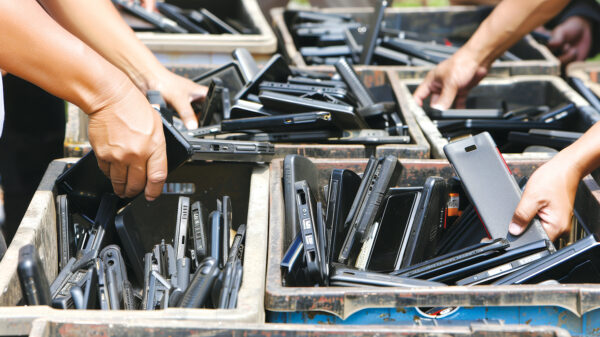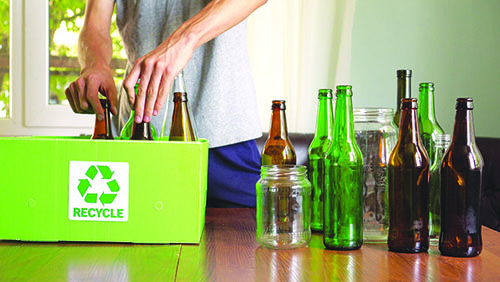by MAURA KELLER
Here’s one thing we know: The paper and plastic recycling industries are in a constant state of flux. In a recent report by the American Forest and Paper Association, the U.S. paper recovery rate increased by 1.4 percentage points in 2015 to a record-high 66.8 percent.
The previous high point of 66.4 percent was recorded in 2011. However, plastic bottle recycling held nearly steady in 2015, with a slight decrease of 0.5 percent from 2014, according to figures released by the Association of Plastic Recyclers (APR) and the American Chemistry Council (ACC). The 26th annual National Postconsumer Plastic Bottle Recycling Report indicates the overall recycling rate for plastic bottles for 2015 was 31.1 percent, down slightly from 31.7 percent the previous year.
In 2016, CalRecycle, also known as California Department of Resources Recycling and Recovery, began developing regulations to implement the tracking of recyclables in California. This new state law requires the Department to collect information from recycling and composting operations and facilities on the types and quantities of materials that are sold, transferred, disposed or exported. Once implemented, this program will dramatically improve CalRecycle’s ability to understand the movement of recyclable materials within and through California.
California’s initiative to monitor and track paper and plastic recycling trends in not an anomaly. Based on surveys performed by CalRecycle, at least 39 other states plus the District of Columbia currently require some level of reporting information on recycling in their state or jurisdiction. Each state manages their system differently. Some states, such as Oregon, have mandatory reporting requirements from municipalities, facilities, businesses, and haulers that handle post-consumer recyclables. Other states, such as South Dakota, rely on voluntary surveys from businesses and municipalities. States have also adopted mixtures of mandatory and voluntary reporting requirements.
According to Ted Davis, vice president, Federal Equipment Company, heavily populated areas seem to have higher recycling rates. In these areas, higher populations contribute to better recycling efforts and more efficient collection practices.
“Our main focus in the recycling industry is the plastics segment,” Davis said. “The sorting of plastics materials is typically done at some intermediary facility where materials are sorted by the type of plastics, like PE, PP, PET, etc.”
Within the plastics segment, Martin Vogt, owner and president of Environmentally Friendly Solutions Plastics, a joint venture of Inteplast Group, a manufacturer of plastics, said the recycling rate of plastics was up until mid-2016.
“Low prime resin pricing is definitely putting a strangle on this industry,” Vogt said. “The rate of recycling depends on the policies and system in place and varies throughout the country but pricing and margins are very low. And finding new end markets are very difficult since manufacturers don’t see such a big price advantage anymore and show low interest in using PCR resins.”
The APR suggested that following 25 consecutive years of growth, several factors contributed to the recent plateau in plastics recycling, including a drop in material collected available for recycling, reduced exports and increased contamination of recyclables. In addition, use of plastic bottles in packaging applications continued to expand but was offset by lightweighting and increased use of concentrates with smaller, lighter bottles.
Samantha Longshore, sustainability advisor at Transwestern, said the East and West coasts of U.S. tend to have the highest recycling rates, which we can attribute to well established infrastructure and subsequently, better recycling habits of occupants within their buildings.
“We have seen a trend in certain areas of an increase in the types of plastics accepted for recycling,” Longshore said. “Numbered plastics and their varying ability to be recycled can serve as a hurdle in ensuring high recycling rates. As municipalities begin accepting more plastic types, this could eliminate some of the confusion and encourage greater recycling of plastics.”
In the world of paper recycling, the trend also is heading in the right direction. According to Paul Kaufmann, founder of Shred Spot in Northbrook, Illinois, it is easier to recycle paper and pricing is on an upswing.
“The top of the upswing is at $170 per ton in our area. In 2011, the sorted office paper (SOP) went as high as $290 per ton, but dropped quickly and has mostly been in the $120 to $150 ton range,” Kaufmann aid. “The market for our paper is doing pretty well as we don’t have an issue finding a mill to buy it. On the occasion that we take in plastic, that is more difficult. Baled stretch wrap is not too bad but baled hard plastic is very difficult for us to sell, especially in smaller quantities.”
So has single stream recycling helped or hurt the paper and plastic recycling industry segments? From Davis’ perspective, single stream recycling has certainly helped increase quality of the end recycled materials as well as helped reduce the cost to recycling materials as the material now arrives at the plastic recycler’s facility.
“This reduces handling and labor costs tremendously,” Davis said. “While paper is often collected and comingled with certain plastics recycling material feed streams, by the time the materials to be recycled have reached our customers, most have already been sorted.”
Longshore stressed that allowing sorting to occur off site and taking the responsibility away from the consumer is one less roadblock. “Food waste is likely to contaminate some of these materials,” Longshore said. “I believe there’s a form of offset experienced from ensuring that recyclable materials are sorted at recycling facilities rather than placed directly into a trash-specific container without the chance for recycling.”
On the other hand, Vogt said single stream has hurt processors, since the material is more contaminated.
“Glass and paper – especially on wet days and in the winter – are a big problem for reprocessors,” Vogt said. “Glass is a problem because it is very abrasive. Wet or even frozen paper cannot be sorted and add a lot of contamination to the plastic stream, especially the mixed plastics and film stream.”
Jafer Patterson, executive vice president at Junk King Franchise Systems, said that single stream recycling has made the idea of recycling easier for consumers, however single stream recycling can have a negative effect on the recycling process.
“Due to the convenience of being able to dispose of all recyclable items in the same bin and then putting the bin on the street, consumers turn a blind eye to process,” Patterson said. “What they don’t realize is that when all recyclable items are housed in the same bin the items can be become contaminated due to the different degrees of recycling products. By recycling this way there is also an increased amount of more broken glass which becomes contaminated and a contaminate. When this happens, there is more of a chance the items will be downcycled instead of truly recycled. This results in a lesser quality item being reproduced from the recycled products.”
There are a myriad of things that can be done on the part of recycling companies and municipalities to increase recycling in the paper and plastic segments. For instance, municipalities can easily implement a pre-sorting effort on the part of the consumer by providing more collection sites with clearly labeled bins where the consumer can drop there discarded recyclable items in the appropriate place.
“This will increase quality as well as reduce costs for the recycling companies,” Davis said. “The better the recycling companies thrive should mean the use of more recycled materials being used and reused over and over again.”
Vogt stressed that municipalities need to commit to processors with supply. “Plastic recycling can be done in an energy efficient way, but it will only work if municipalities start to work more closely with the industry, by providing guaranteed good quality supply,” Vogt said. “They need to pay more attention to the quality of the processor and the actual recycling rates and not just the price. Also, with such low resin pricing, brand owners and manufacturers need to commit to use recycled resins. We need to learn to understand that the cost of not recycling is much higher than just the cost for landfilling our waste.”
Davis believes that as the technology of recycling evolves and awareness of recycling everyday products grows, that the paper and plastics recycling markets will realize not only a steady growth but also an increased demand for recycled materials.
“I think plastic recycling is needed more than ever, especially with more and more packaging being converted to plastic,” Vogt said. “We can’t keep throwing it out, filling up landfills and contaminating our oceans. Plastic recycling makes sense. It saves energy and protects our country and environment. People must really begin to understand this.”
Industry experts agreed that increasing the number of paper and plastic types accepted for recycling could increase rates. “Recycling companies and municipalities that provide properties with well-labeled waste containers and signage could also help, but, unfortunately, even an instructional poster can be ignored,” Longshore said. “Education and habit-building are ultimately key. With knowledge, recycling can become second nature.”
Kaufmann agreed. “The one thing that I know will help is making it clear to consumers what the actual benefits are from the recycling,” Kaufmann said. “People are always surprised when I tell them how many trees are saved by our recycling of paper –17 trees per ton of paper. So a single truckload of baled paper sent to the mill – 42,000 to 45,000 lbs. – saves about 375 trees.”
“While the paperless society is a myth, we are a lesser paper society,” Kaufmann said. “While that may decrease the amount of paper available to recycle, the fact that identity theft and theft of important information is an ever-growing problem means that we will be recycling a greater percentage of paper, so the industry will not go away. I believe the paper shredding industry will change as the total amount of paper may decrease and there will be a continued migration from on-site shredding trucks to more efficient plant-based shredding.”
Published in the February 2017 Edition of American Recycler News







